Last updated: December 14, 2017
Article
Jolley Gulch Fire Spread Limited by Prior Prescribed Fires
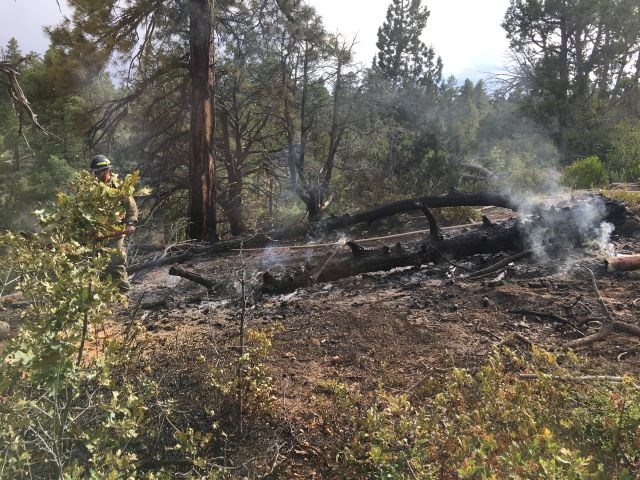
The Incident:
On Sunday July 23, 2017, lightning ignited a wildland fire in the East Zion Area, near the eastern boundary of Zion National Park. Engine 403 from Zion National Park responded to the fire report and found a large ponderosa pine on fire just inside the NPS boundary. Burning debris from the struck tree had fallen to the ground and started a fire around its base. The Jolley Gulch fire, so-named for the geographic feature nearest its origin, did not grow beyond the area around the tree due to lack of vegetation and fuels through which to spread. The low fuel loading was not by chance, but was a product of numerous years of planning and projects intended to generate just such an outcome. Firefighters were easily able to extinguish the fire without requiring additional resources, holding it to less than one acre. Had the lightning struck a tree in an area that had not been treated with fuel reduction measures, the fire would have easily spread to surrounding vegetation and crossed the park boundary, threatening private lands and multiple structures, residences and businesses adjacent to the park.
Numerous residents were at their cabins over the weekend and heard and/or saw the lightning strike. They were impressed with the response of Zion firefighters and expressed their gratitude for their hard work and for containing the wildfire to less than an acre. They recognized the potential for worse outcomes had the park not performed fuels reduction within its boundary. After containing the fire, firefighters spoke with residents about the importance of maintaining their properties to reduce the risk from wildland fires and offered guidance on how to accomplish this.
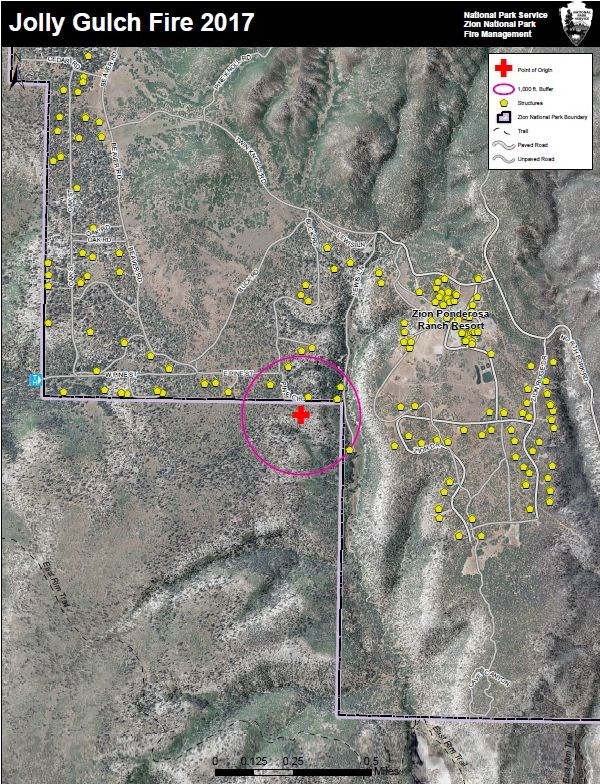
The Location:
The East Zion Area, where this fire start occurred, had previously been identified as one of six original wildland-urban interface (WUI) “Focus Areas” located in the Color Country Interagency Fire Management Area. These focus areas were recognized to require immediate fuel reduction to protect communities and properties from the threat of wildland fire. Numerous wildland fires have occurred in this area and reducing the risk from them in this populated zone was a high priority for the park.
As shown on Map A, the East Zion Area has seen significant development over the past few years. An estimated 158 structures now exist within the area, with 62 of these within 1000 feet of the park boundary. Many of these could have been impacted by the Jolley Gulch Fire had it the fuel to spread. The Zion Ponderosa Ranch Resort’s heavily developed recreation area has several cabins, outbuildings and other structures less than a half mile from the ignition site. It, too, was potentially vulnerable to the Jolley Gulch fire. Recognizing the significant values at risk, the park has implemented numerous projects through the years to reduce the amount of vegetation in the area and thereby reduced the risks to structure, property and people.
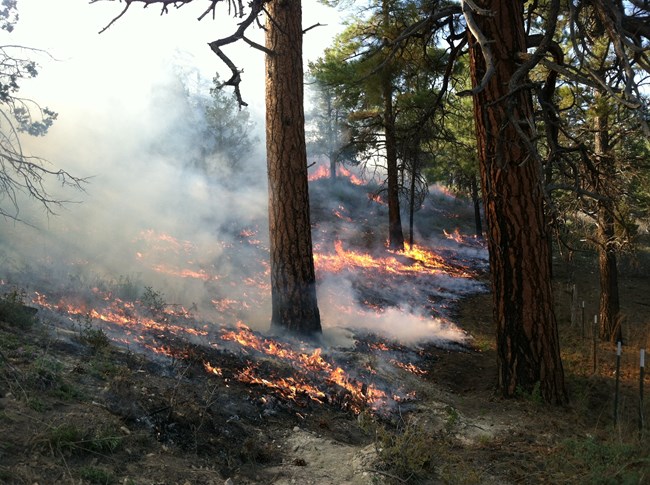
The Ponderosa Pine Ecosystem:
Ponderosa Pine forest, the ecosystem in which the Jolley Gulch fire occurred, was historically a fire-adapted landscape. Its fire regime was typified by low intensity, low severity surface fires occurring every 7-25 years, consuming the fuels that accumulated on the forest floor. This frequent fire return interval combined with the fire resistant traits of the Ponderosa Pine (thick, fire-resistant bark and tendency to "self-limb") kept fires low to the ground, out of the crowns of the trees, creating a stable cycle.
In the early 20th century land managers were directed to suppress all wildfires. A lengthy period of full fire suppression led to build-up of fuels on the forest floor. Recognizing its natural and important role in the landscape, the National Park Service added fire as a tool to manage the Ponderosa Pine ecosystem in a more natural state. Periodic prescribed burning (see image above) and management of naturally occurring lightning caused wildfires reduces fuels and plays a critical role in the health and maintenance of the Ponderosa Pine Forest.
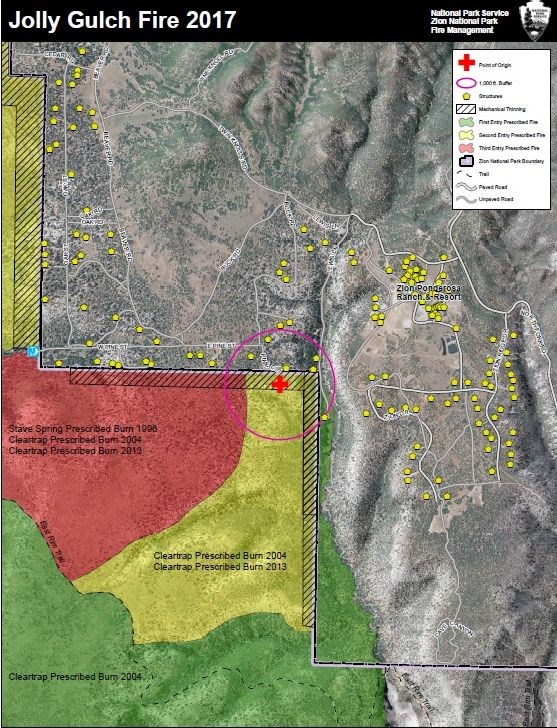
Treatment History:
The first re-introduction of fire for fuels reduction in the East Zion Area of Zion National Park began in the mid-1990s. It continued in the Jolley Gulch area with the Clear Trap Prescribed Burn (Rx) in 2004 (see Map B). This burn treated 4,000 acres along the park boundary. Quoting directly from the Clear Trap Rx Burn Plan, “ The project goals are to reduce the wildland fire hazard along the park boundary, and to restore the natural role of fire to the ecosystem.” This Rx was followed by a second entry burn of 650 acres in 2013 that mainly re-treated the area along the park boundary, further reducing fuel loads and the associated risk of a wildland fire escaping the park and threatening private property and structures.
In 2006 and 2008, the park conducted the East Mesa Rx, a prescribed fire just to the north of the Clear Trap Prescribed Burn. This project added 2300 acres of treated area along the park’s eastern boundary. Together, these projects and others reduced fuel loads along almost five miles of park boundary adjacent to private land and structures (see Map C).
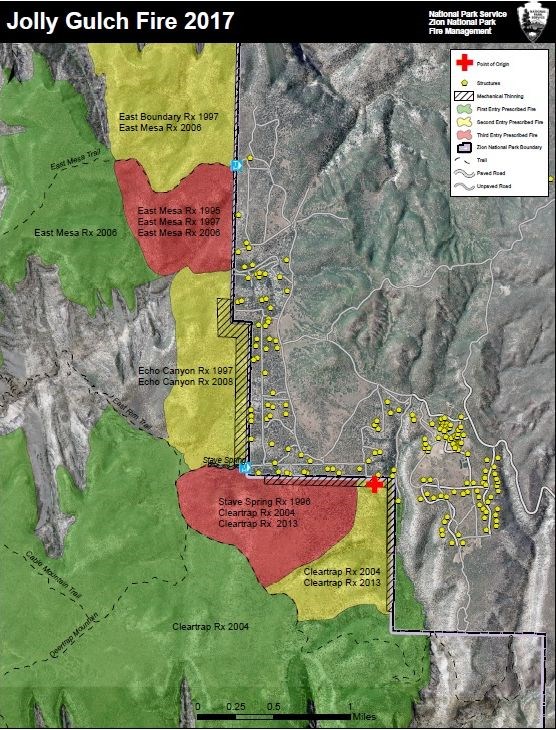
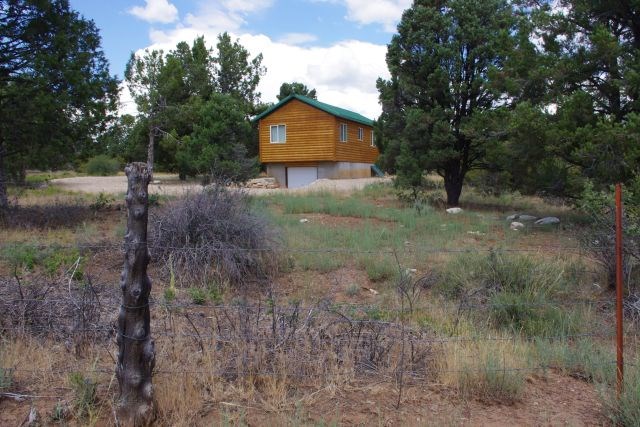
Outcome:
The Jolley Gulch Fire is a case in point of how prescribed fire treatments can slow or stop the movement of a wildland fire by reducing or eliminating the fuels a fire needs to spread. Areas that have been treated also provide firefighters the time and safer conditions they need to contain and extinguish the fire. Combined, these factors allowed for the prompt extinguishment of the Jolley Gulch Fire before damage to life or property could occur.
While prescribed burns are a significant investment of resources and create temporary short-term smoky conditions during implementation, they provide a potentially critical level of protection to values at risk. They move landscapes and communities towards greater resiliency from the negative effects of wildland fire.
As evidenced by this incident, fuel treatments in Zion National Park benefit both the park and landowners and residents of the East Zion area. They provide all stakeholders with a lowered risk from wildland fire, but also benefit the resource by re-introducing fire to the fire-adapted ponderosa pine ecosystem. The policy of using fire as a management tool helps decrease risks to life, property and resources, and perpetuates the values for which the park was established.
